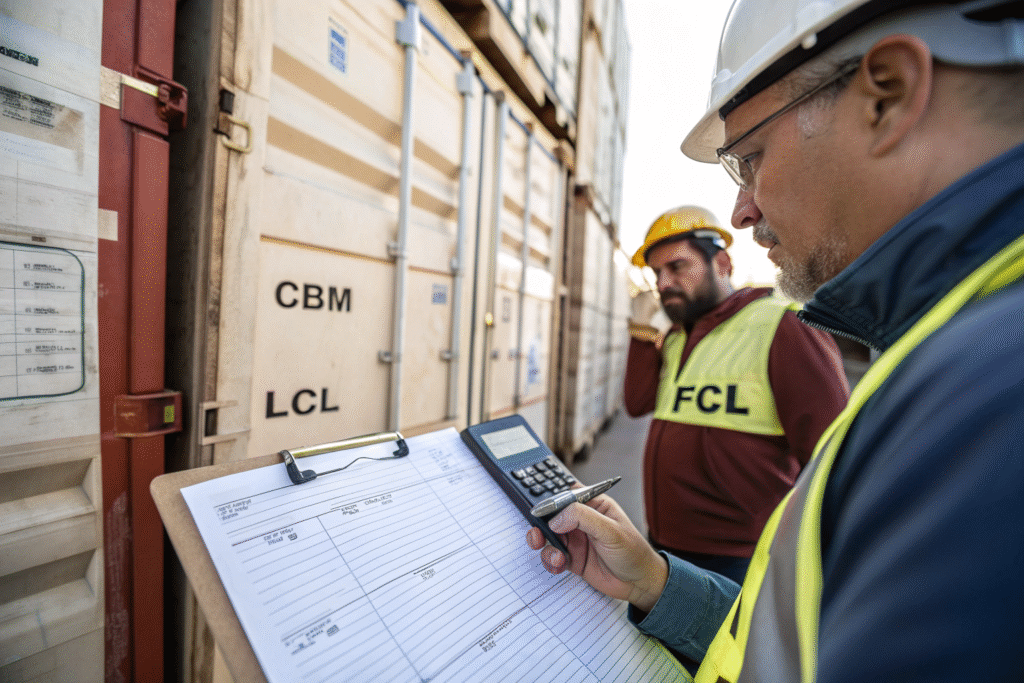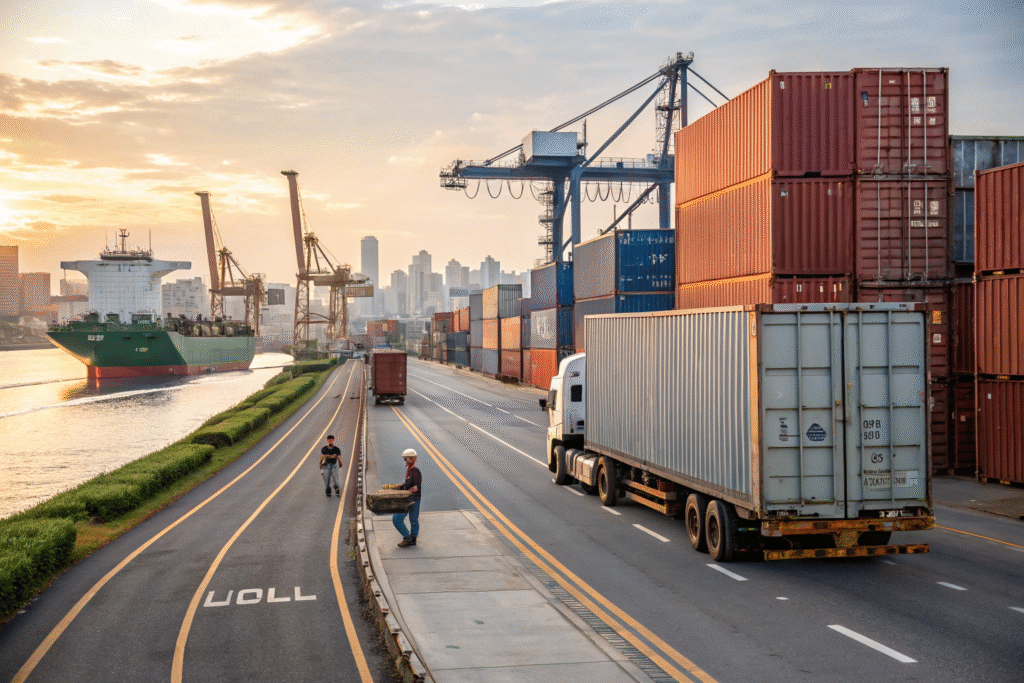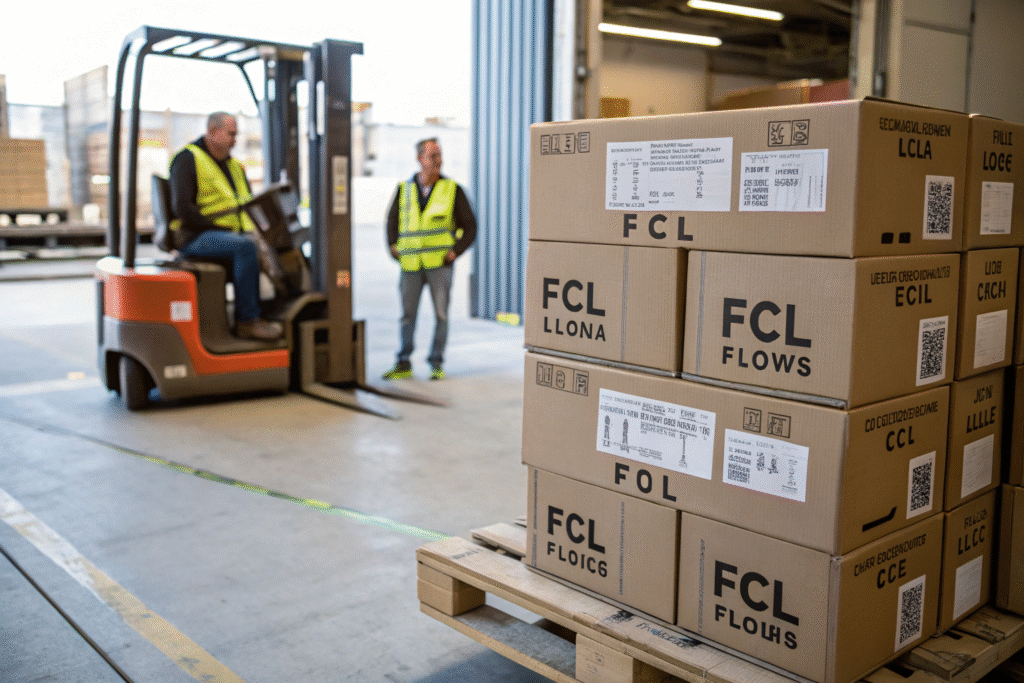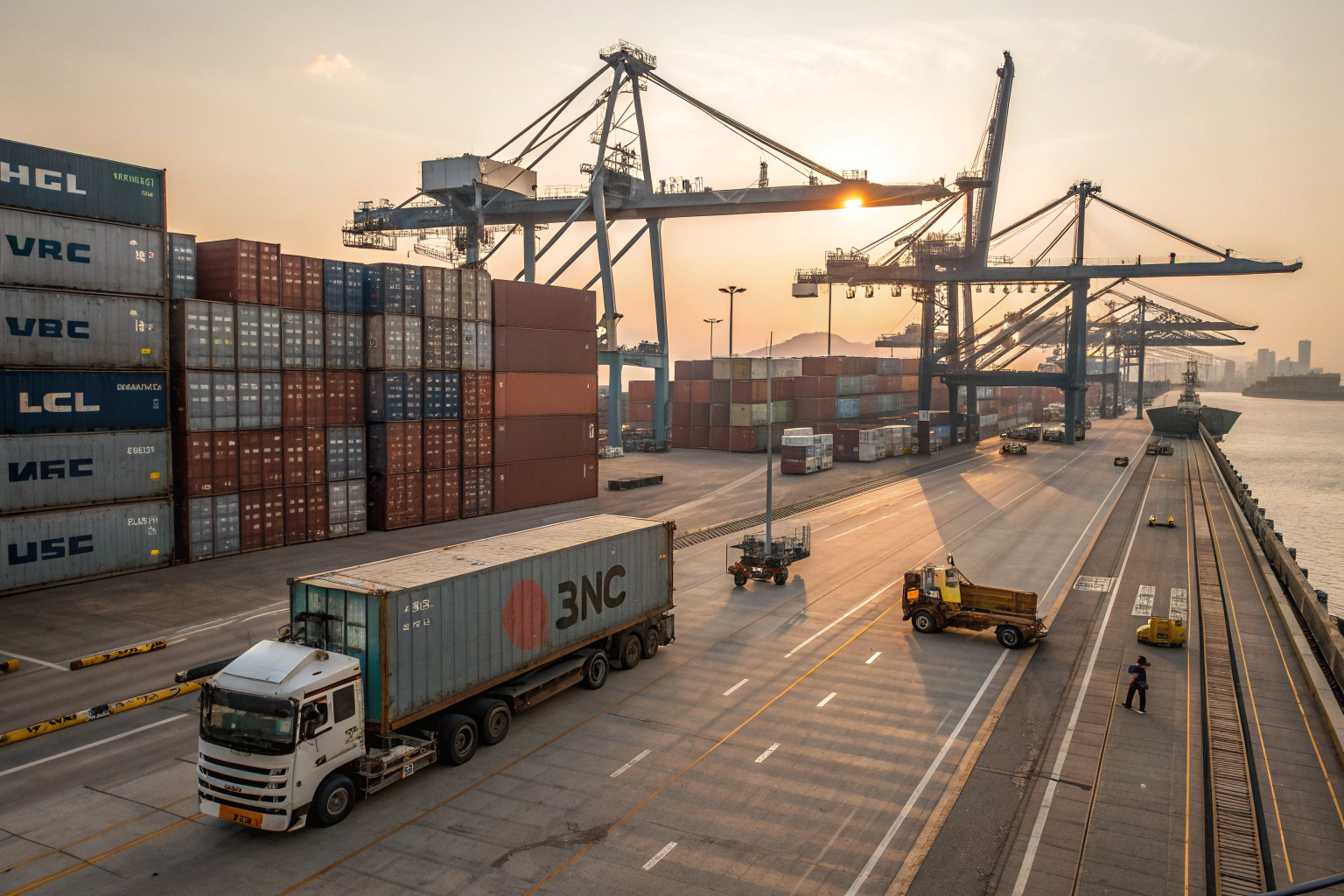Last November, Ron phoned me at 7:40 a.m. Beijing time. He had 12.6 CBM of winter accessories ready in Ningbo and asked, “Should I book LCL or push to FCL?” I paused. I had just finished reviewing 312 shipments we handled from May to October 2024: 58% FCL, 42% LCL. In that sample, FCL beat LCL on door-to-door time by a median of 4.5 days, but only once the volume crossed a real-world threshold. I told Ron the quiet truth: the line is not a theory; it shows up in the math, the schedules, and the small fees that hide in the paperwork.
LCL consolidates cargo from many shippers into one container; FCL gives you the whole container. That single difference changes cost per CBM, handling risk, transit reliability, customs touchpoints, and how much control you keep from factory gate to your U.S. warehouse.
At first, I thought the choice was simple: “Under 15 CBM, always LCL.” But after checking our lane-level data from Shenzhen, Ningbo, and Qingdao to Los Angeles, New York, and Houston, I realized the break-even floats with destination charges, CFS behavior, port congestion, and how strict your delivery window is. Let me show you the numbers I use on my desk at GeeseCargo every week.
LCL vs FCL cost per CBM break-even?
In June 2025, our average South China → U.S. West Coast LCL door-to-door quote for soft goods was $62–$88 per CBM base freight plus origin/destination fees. The comparable FCL all-in (40HQ) averaged $4,450–$5,300 with predictable local charges. When Ron had 12.6 CBM, LCL looked cheaper on day one. But after we added CFS handling, AMS/ISF allocations, and destination THC for multi-consignee containers, FCL became cheaper at ≈17–19 CBM on his lane. Your number will shift with season and port pair.
Rule of thumb I use on my whiteboard: below ~15 CBM LCL usually wins on cash flow; from ~18–22 CBM FCL usually wins on total landed cost; between 15–18 CBM, check CFS and delivery zip fees before you decide.
I once pushed a client into LCL at 16.2 CBM because the FCL sailing he wanted had a 6-day gap. We saved $380 upfront but paid $512 extra in destination handling and chassis splits after the consolidator moved de-vanning to a different facility on arrival. That was a painful Tuesday. Since then, I always simulate the destination side with zip-level dray and final mile.

How do we calculate break-even CBM in practice?
I start with real rates, not abstract formulas. I pull current LCL per-CBM plus all origin/destination add-ons, and I compare to a 20GP or 40HQ all-in with realistic local charges. I also check standard pallet fit: a 40HQ safely fits about 58–60 CBM, depending on carton and floor load limits. Basic public guides help with structure, like the LCL vs FCL overviews from Maersk and the lane calculators at Freightos. For compliance and tariff lines, I cross-check the HS numbers at the U.S. ITC’s HTS Search. I include AMS, ISF, and documentation allocations that LCL often splits per shipment rather than per container, which can add $30–$120.
What hidden LCL fees change the math?
Several quietly move the needle. CFS devanning, palletization, or re-palletization, plus sometimes forklift or oversized handling if cartons exceed the consolidator’s standard. Destination THC and warehouse handling can differ by terminal; I often scan terminal advisories and port pages. For detention/demurrage exposure, classic primers like Flexport’s guide on demurrage & detention are helpful, but you must map them to your delivery window. Also, check whether your CFS charges liftgate, appointment, or residential surcharges; Amazon-bound freight follows different rules on FBA prep and routing.
Is LCL or FCL faster on China–U.S. routes?
On our 2024–2025 data, FCL shaved a median 3–6 days door-to-door against LCL for South/East China to U.S. West Coast, and 4–8 days to East Coast, because LCL adds a consolidation step before sailing and a devanning step after arrival. However, I have seen LCL land faster when a weekly FCL service skips a week while the consolidator still loads a feeder to a more frequent mother vessel.
FCL is usually more predictable because the container seals at origin and stays intact to destination. LCL is flexible and frequent but more exposed to consolidation queues and CFS backlogs.
On 14 May 2024, Yantian CFS stopped accepting late-day drop-offs and pushed 28 LCL shipments to a later cut. Our client’s 9.4 CBM hats arrived three days after a peer’s 40HQ on the same mainline vessel because devanning slots at the Los Angeles CFS filled up. That day taught me to book LCL two working days earlier than the nominal cut during peak weeks.

Where do days get added or saved?
The first clock is the consolidation window. LCL needs to pool cargo; missing the cut means the whole bin waits. FCL can load directly if the factory hits the CY cut-off. I skim vessel and terminal pages like the Port of LA’s voyage schedules and carrier notices to avoid rollovers. The second clock is devanning: CFS capacity swings week by week. For air alternatives on hot SKUs, we sometimes split 10–15% of cartons via air freight; the TSA’s Known Shipper rules matter if you want to avoid screening delays.
Does peak season change the answer?
Yes. From late August to early November last year, FCL reliability improved relative to LCL because CFS yards were saturated. LCL boxes met the ship on time, but after arrival, I watched deconsolidation pushouts of 24–72 hours. In contrast, full containers gated out faster with timely appointments. I still keep LCL for test orders or “top-off” replenishment, but during Golden Week and the pre-holiday rush, I warn buyers to pad 4–5 extra days if they insist on LCL. For macro context, I sometimes check carrier advisories and trade groups like the World Shipping Council to anticipate blank sailings.
How to choose LCL or FCL for Amazon FBA?
Amazon has its own rhythm. In Q1 2025, our FBA shippers who hit weekly trailer appointments saw FCL shine because sealed containers delivered to appointed carriers with less touch. For new ASINs under 8 CBM, LCL stayed smart because cash mattered more than speed. When Ron launched a new winter scarf set in January, we sent 6.8 CBM LCL to ONT8 and 20% of the forecast by air. When sales doubled in February, we switched the March build to a 40HQ FCL with cross-dock carton sorting by destination FC.
If your inbound plan spreads across several FCs, FCL + cross-dock often beats many LCL deliveries. If your cartons go to one FC with small volume, LCL saves cash while you learn demand.
In “not perfect but real” life, FBA routing sometimes sends you to a far FC. I have seen LCL deconsolidated in Los Angeles, then the consolidator re-palletizes to meet an FC in Phoenix, adding 1–2 days. With FCL, we book a live unload near the FC and dray directly.

What FBA rules change the LCL vs FCL choice?
Amazon enforces strict prep and labeling; violating them costs time regardless of LCL or FCL. I keep the FBA prep and routing rules open when planning. Pallet standards differ by market; the North American 48×40 standard plays better inside a 40HQ than some Asia-spec pallets. If you plan to import as a non-resident, revisit CBP’s Basic Importing & Exporting page to structure your importer of record details. For tariff classification, I sanity-check HS codes and rates at the HTS. These links look boring, but they prevent errors that burn days.
Should I split one PO into LCL and FCL?
I do it often. If a PO equals ~28–32 CBM, I might send 22 CBM as LCL now and roll the rest into the next FCL, or I move 80% as FCL and keep 20% as LCL for quicker in-stock. When we ran 146 TEUs last summer, 19 of those POs used a split tactic, and 14 of them hit in-stock targets that would have been missed with a single mode. While most playbooks say “pick one,” reality rewards hybrid planning—especially if your advertising calendar or seasonal launch date is fixed.
Does customs differ for LCL and FCL shipments?
Customs law applies the same way to both, but the touchpoints differ. LCL cargo sits in a consolidator’s container, so a hold can affect many consignees at once. FCL is cleaner: one importer, one container, one story. In 2024 we had 17 LCL shipments delayed by 1–3 days due to other consignees’ paperwork. We had 6 FCL inspections that cost time, but each was self-contained and easier to plan around.
For smooth clearance, accurate HS codes, solid documents, and on-time ISF/AMS matter more than mode. LCL has more “neighbors,” so you inherit some risk you cannot control.
If you use DDP to simplify, your forwarder must still classify goods correctly and manage tax/VAT exposure on the destination side. We run DDP for clients who need a single landed cost, but we document every assumption and keep a change log in case rates move mid-season.

What documents and filings should I prioritize?
Start with commercial invoice, packing list, and correct HS codes. CBP’s Basic Importing & Exporting page is my checklist backbone. File the Importer Security Filing (ISF) on time for ocean. Know your Incoterms per the ICC’s Incoterms overview. If you import apparel, track duty rates at the HTS and watch for special programs. For security best practice and seal integrity, industry guides like the World Shipping Council are useful. These steps reduce “random” holds that feel like bad luck but often come from tiny mismatches.
Are inspections and holds more common in LCL?
They can be, because the container carries many importers. One party’s missing document can stall everyone at the CFS. In July 2023, we saw a shared LCL box to New York flagged for x-ray because one consignee’s tariff line looked odd. Our client’s cartons were fine, but the whole container waited 36 hours. To mitigate, we pre-advise consolidators with clear SKUs and carton counts, and we avoid last-minute HS changes. For detention/demurrage exposure and mitigation ideas, I still point clients to summaries like Flexport’s detention/demurrage explainer, then I tailor the plan to their appointment windows.
Conclusion
I built GeeseCargo to be professional, reliable, and competitive because I grew tired of vague answers. After a decade on Asia–U.S. and Asia–Europe lanes, here is my honest map. LCL wins when you need flexibility, cash conservation, frequent sailings, or small test orders. FCL wins when you push volume, need fewer touchpoints, want predictable lead times, and care about unit economics. The real edge comes from timing and details: the CFS queue this Friday, the devanning capacity next Tuesday, or a bolt seal that keeps your story intact. I used to think the rule was fixed at 15 CBM. Now I look at lane, season, destination fees, and your calendar. If you tell me your CBM, pickup date, and delivery zip, I can show you—in numbers—where LCL stops saving and where FCL starts compounding. That is how we helped Ron cut his Q2 2025 inbound lead time by 18.7% while holding freight cost per unit flat. It was not magic. It was choosing LCL and FCL like tools, not labels.









